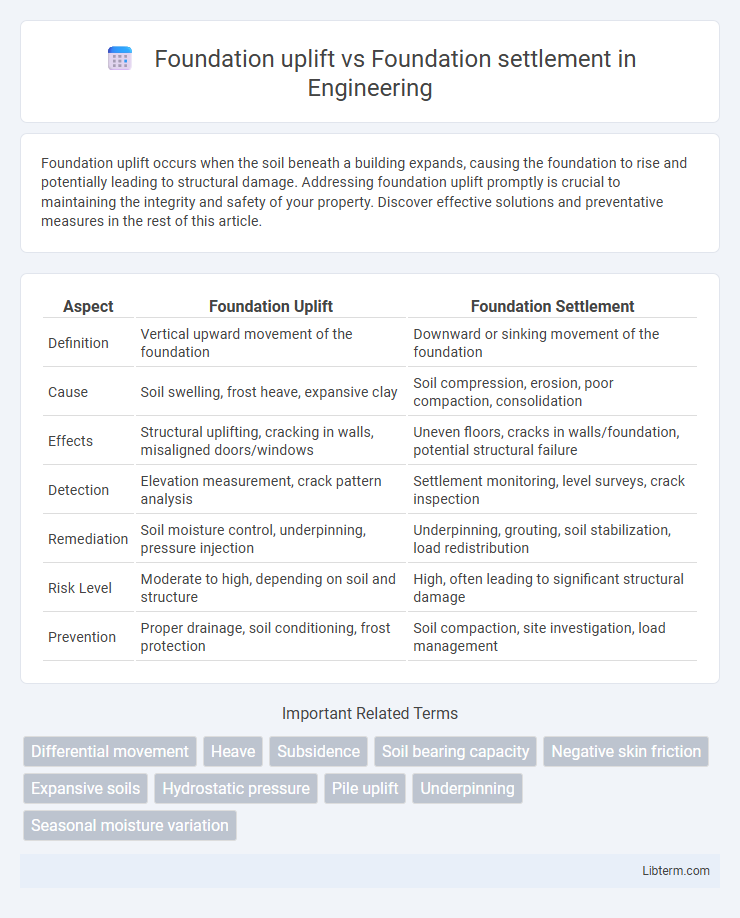Foundation uplift occurs when the soil beneath a building expands, causing the foundation to rise and potentially leading to structural damage. Addressing foundation uplift promptly is crucial to maintaining the integrity and safety of your property. Discover effective solutions and preventative measures in the rest of this article.
Table of Comparison
| Aspect | Foundation Uplift | Foundation Settlement |
|---|---|---|
| Definition | Vertical upward movement of the foundation | Downward or sinking movement of the foundation |
| Cause | Soil swelling, frost heave, expansive clay | Soil compression, erosion, poor compaction, consolidation |
| Effects | Structural uplifting, cracking in walls, misaligned doors/windows | Uneven floors, cracks in walls/foundation, potential structural failure |
| Detection | Elevation measurement, crack pattern analysis | Settlement monitoring, level surveys, crack inspection |
| Remediation | Soil moisture control, underpinning, pressure injection | Underpinning, grouting, soil stabilization, load redistribution |
| Risk Level | Moderate to high, depending on soil and structure | High, often leading to significant structural damage |
| Prevention | Proper drainage, soil conditioning, frost protection | Soil compaction, site investigation, load management |
Understanding Foundation Uplift and Settlement
Foundation uplift occurs when the soil beneath a structure expands due to moisture increase, causing the foundation to rise and potentially crack walls or floors. Foundation settlement refers to the gradual sinking or settling of a building's foundation, often caused by soil compaction, erosion, or inadequate load-bearing capacity. Understanding these phenomena is crucial for diagnosing structural damage, implementing effective repair strategies, and maintaining building safety and integrity.
Causes of Foundation Uplift
Foundation uplift primarily occurs due to soil expansion caused by moisture increase, often from leaking pipes or poor drainage near the foundation. Clay soils are highly susceptible to swelling when saturated, exerting upward pressure on the foundation. Tree roots extracting water and seasonal changes in groundwater levels also contribute to soil movement leading to foundation uplift.
Common Triggers of Foundation Settlement
Foundation settlement commonly triggers include poor soil compaction, moisture fluctuations causing soil shrinkage or expansion, and improperly designed or constructed foundations failing to distribute loads evenly. Organic materials in the soil decomposing over time and nearby construction activities causing vibrations or soil displacement also contribute significantly to uneven settlement. Identifying these causes early can prevent structural damage and costly repairs.
Signs and Symptoms of Foundation Uplift
Foundation uplift is characterized by visible cracks in walls and floors that appear uneven or slanted, often accompanied by doors and windows that stick or fail to close properly. Homeowners may notice gaps forming between walls and ceilings or flooring that buckles, indicating upward movement of the foundation. Unlike foundation settlement, which causes sinking and settling symptoms, uplift typically results in upward shifts leading to structural misalignment and stress points in the building framework.
Identifying Foundation Settlement Issues
Foundation settlement occurs when soil beneath a structure compacts or shifts, causing the foundation to sink unevenly and result in cracks, doors sticking, or misaligned windows. Identifying foundation settlement issues involves measuring the extent of vertical displacement, observing visible damage patterns, and conducting soil analysis to determine the stability and load-bearing capacity. Early detection through professional inspection and monitoring prevents progressive structural damage and costly repairs.
Comparing Uplift and Settlement Effects on Structures
Foundation uplift causes structural components to shift upward due to soil expansion or frost heave, resulting in cracks and misalignment often concentrated near the base. In contrast, foundation settlement occurs when soil beneath a structure compresses, leading to uneven sinking and differential stress that can warp walls and floors. Comparing both effects, uplift primarily induces tensile stress and potential fractures at connections, whereas settlement generates compressive stress and uneven load distribution, requiring distinct engineering solutions for stabilization.
Structural Risks of Foundation Movement
Foundation uplift occurs when soil expansion or frost heave forces the foundation upward, potentially causing cracks and misalignment in the structure's load-bearing elements. Foundation settlement involves the sinking or downward shifting of the foundation due to soil compaction or moisture loss, leading to uneven floors, wall fissures, and compromised structural integrity. Both foundation uplift and settlement pose significant structural risks by inducing stress on beams, columns, and joints, which can result in long-term damage or failure if not properly addressed.
Inspection and Diagnosis Methods
Foundation uplift is typically diagnosed through detailed geotechnical surveys and structural monitoring that detect upward soil pressures or heaving, while foundation settlement is assessed by measuring vertical displacement using leveling instruments, laser scanning, or inclinometers. Inspection methods for both conditions often include visual examinations for cracks, tilting, or misalignment, combined with soil sampling and moisture content analysis to identify underlying causes. Advanced diagnostic techniques such as ground-penetrating radar (GPR) and load testing can provide precise data on foundation movement patterns and soil bearing capacity.
Repair Solutions for Uplift and Settlement
Foundation uplift occurs when soil beneath a foundation expands, causing the structure to rise, while foundation settlement involves the gradual sinking of the foundation due to soil compression or erosion. Effective repair solutions for uplift include installing pressure relief valves, installing helical piers, or using slab jacking to re-level the foundation. For settlement, common remediation methods involve underpinning with steel piers, mudjacking to fill voids, or injecting polyurethane foam to stabilize and lift the foundation.
Preventive Measures and Maintenance Tips
Foundation uplift occurs when soil expands below the foundation due to moisture increase, while foundation settlement results from soil compression under load. Preventive measures include proper site drainage, controlling moisture levels using gutters and downspouts, and installing moisture barriers to minimize soil fluctuations. Regular maintenance tips involve inspecting for cracks, ensuring foundation vents are clear, and maintaining consistent watering schedules around the foundation to prevent uneven soil movement.
Foundation uplift Infographic

 libterm.com
libterm.com